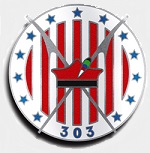Hobby Master HA7850B RAF Supermarine Spitfire Mk. Vb Fighter - Squadron Leader Jan Zumbach, No.303 (Polish) Squadron, Summer 1942 [Kemble Air Show, June 2011] (1:48 Scale)
"Kosciuszko Squadron"
- Nickname for No.303 (Polish) Squadron
 The Spitfire is the most famous British aircraft of all time. Although less numerous than the Hawker Hurricane, it is remembered as the sleek, thoroughbred fighting machine that turned the tide during the Battle of Britain. The Spitfire was among the fastest and most maneuverable prop-driven fighters of World War II, serving in virtually every combat theater.
The Spitfire is the most famous British aircraft of all time. Although less numerous than the Hawker Hurricane, it is remembered as the sleek, thoroughbred fighting machine that turned the tide during the Battle of Britain. The Spitfire was among the fastest and most maneuverable prop-driven fighters of World War II, serving in virtually every combat theater.
Supermarine designer Reginald Mitchell created this small, graceful, elliptical-wing fighter with eight guns in the wings that were able to fire without being hindered by the propeller. The immortal Spitfire thus became not merely one of the best-performing fighters of all time, but also one of the best-looking. Although never employed as a long-range escort, the Spitfire was a champion in an air-to-air duel. Spitfires routinely dived at the speed of sound, faster than any of the German jets.
A carrier-based version, called the Seafire, was a winner in its own right, serving valiantly on convoy routes during World War II. The Seafire 47 was even used in the early stages of the Korean War, before it was replaced by more modern jet aircraft.
Pictured here is a 1:48 scale replica of a Supermarine Spitfire Mk. Vb fighter that was piloted by Squadron Leader Jan Zumbach, who was attached to No.303 (Polish) Squadron during the summer of 1942 and display at the Kemble Air Show in June 2011.
Sold Out!
Dimensions:
Wingspan: 9-inches
Length: 7-1/2-inches
Release Date: December 2021
 Historical Account: "Rafałki" - No.303 Squadron RAF (Polish: 303 Dywizjon Myśliwski "Warszawski im. Tadeusza Kościuszki") was one of 16 Polish squadrons in the Royal Air Force (RAF) during the Second World War. It was the highest scoring of the Hurricane squadrons during the Battle of Britain).
Historical Account: "Rafałki" - No.303 Squadron RAF (Polish: 303 Dywizjon Myśliwski "Warszawski im. Tadeusza Kościuszki") was one of 16 Polish squadrons in the Royal Air Force (RAF) during the Second World War. It was the highest scoring of the Hurricane squadrons during the Battle of Britain).
No.303 Squadron RAF was formed in July 1940 in Blackpool, England before deployment to RAF Northolt on August 2ndas part of an agreement between the Polish Government in Exile and the United Kingdom. It had a distinguished combat record and was disbanded in December 1946.
"Had it not been for the magnificent material contributed by the Polish squadrons and their unsurpassed gallantry," wrote Air Chief Marshal Sir Hugh Dowding, head of RAF Fighter Command, "I hesitate to say that the outcome of the Battle (of Britain) would have been the same.


